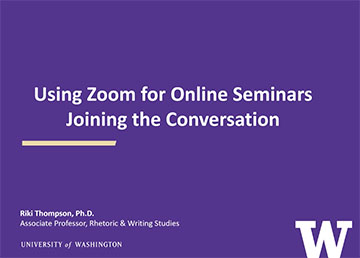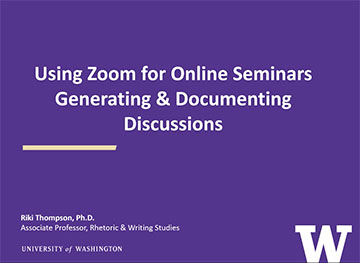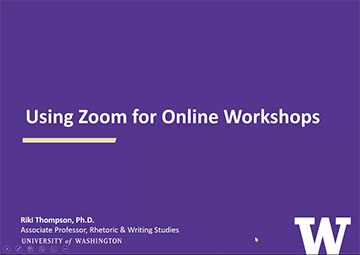Main Content
Tips for Creating Lectures That Students Will Actually Watch
"Chunk" your Lectures!
- Average lecture segments should be 7-10 minutes. This allows students to digest every part of the lesson, quickly revisit what they may not have understood and provides a meaningful place to pause if they need to return to the lesson later. Also, It is much easier to re-record 10 minutes than 50 minutes should you run into any technical issues or make a mistake.
- Adhere to the "Ted Talk Rule" where no presenter, no matter who they are, is allowed to deliver a talk more than 18 minutes.
- Tip for implementation: If you are used to longer lectures, review your lessons and identify where the natural breaks in the material might be. Use these as a guides to decide where every recording should begin and end.
Use Visuals, Images and Animations (wisely)
- Avoid the “talking head” lecture. Visuals can enhance your presentation and make material more accessible.
- Share your screen with students so they can see your presentation, graphs, figures, drawings and your face all at the same time.
- Keep a good pace. Avoid rushing through
- Tip for implementation: Text-heavy slides can make it difficult to pay attention to what a speaker is saying. Mix it up and try slides using a single large image. This creates a need for students to listen more to what you are saying instead of just reading the words behind you. This also gives students a reason to take more detailed notes.
Create Guided or Embedded Questions
- Pause to ask students a question, provide a worksheet that they need to complete as they watch the lecture, or create a task for them to do in between videos.
- Tip for implementation: How do you make sure that students complete guided questions or worksheets? Have them submit their answers as an assignment. This can also help you assess your students’ understanding of the material.
Test Knowledge with Quizzes and Self-assessment
- Create frequent, low stakes quizzes. Students will need to pay closer attention to video lectures if they know you will assess their knowledge as they progress.
- Provide opportuniities for students to self-assess with an ungraded reflection, survey or have them lead a class discussion.
- Tip for implementation: Ask students what they are having trouble with. At the end of a unit, have students assess themselves by asking what their “muddiest point” is or what they would like to learn more about and have them submit their responses via Canvas.
Use Pre-existing Videos or Learning Objects
- You do not always need to create original videos. Many great Open Educational Recouce videos exist that already do a good job of explaining specific topics. This also creates more variety in students’ learning experience and can be less time intensive for the instructor.
- Videos
- Vimeo Creative Commons Licensed Videos Browse through all of the Creative Commons licensed videos available on Vimeo.
- Ted Talks Explore Ted Talks by Topic. Most Ted Talks are licensed CC BY-NC-ND 4.0 International (attribution, non-commercial, no derivatives).
- Find Animations & Learning Objects
- Wisc-Online A collaborative effort from the 16 colleges in the Wisconsin Technical College System this resource provides 'learning objects' or small modules for basic concepts like "summarizing" in the humanities or the "anatomy of the heart" in life sciences. Has a robust browsing function.
- PhET Interactive Simulations Interactive simulations for science and math.
- Tip for implementation: Explore what resources are available before you begin recording your own videos to gain an understanding of what currently exists and what you need to do yourself.
Be Yourself!
Lastly, remember that this is not a Hollywood production! One of the most important things to do in a video is to be yourself and act natural. It is okay to stumble over a word or quickly correct yourself when you make a mistake. This allows students to truly see your personality and connect with what makes you unique as an instructor.
Tips for implementation: Record a test video, then go back and watch it (bonus points if you have someone else watch it too!). Evaluate what you do well and what needs improvement. Feel free to experiment with environment and style until you feel that you are able to convey yourself in a way that is comfortable and genuine.
Source: Adapted from Simuelle Myers, Instructional Designer, Temple University. 6 Tips for Creating Engaging Video Lectures That Students Will Actually Watch
Faculty Showcase: Sometimes you don't have to do traditional lectures...
Teaching a Lab Class Online
Julian Yamaura
Department of Civil & Environmental Engineering | UWS
3 Approaches to Teaching/Leading Students via Zoom
Riki Thompson | SIAS | UWT



Low tech tips for quickly moving (social science & humanities) content online
Tips for Creating Written Lectures - Natalie Jolly | SIAS | UWT
1. Write your content rather than recording it (This allows for content to be easily updated)
- Create a written lecture/discussion
- Rather than writing a separate lecture file and discussion question, consider merging the two into a multi-part, open-ended, content-filled discussion question each week or each lesson. Doing so allows different students to engage with different portions of your lecture (as they would in-class) and results in a variety of different student posts (rather than 40 identical posts) that students can then read/learn from.
- To do so, distill your lecture down to the key elements and, after each point, pose a few questions for your students to expand upon.
- Incorporate images, links, files, Youtube videos, etc. to break up big blocks of text.
- Below is a sample online lecture/discussion question (apologies for the awkward formatting):
- Rather than writing a separate lecture file and discussion question, consider merging the two into a multi-part, open-ended, content-filled discussion question each week or each lesson. Doing so allows different students to engage with different portions of your lecture (as they would in-class) and results in a variety of different student posts (rather than 40 identical posts) that students can then read/learn from.
2. Encourage peer engagement on the discussion board
- The online format allows for peer-based learning, and you can take advantage of this by requiring your students to respond to other posts on the discussion board. Requiring students to include things like direct quotes from the reading, external links from the web, etc. in their posts can further augment the caliber of the conversation.
- Encourage your students to end their posts with questions rather than statements to create
- Opportunities for other students to respond. A dynamic exchange can develop when they do so.
- Sample student reply to the above discussion question:
- Encourage your students to end their posts with questions rather than statements to create
Threaded peer replies to the student post above:
| Student 1 replies to the above student’s post |
Student 2 replies to both of the above student posts, and joins the conversation
3. Manage grading in an online format
- With 40 posts and even more replies, the amount of grading can quickly become overwhelming. Consider developing an explicit rubric that allows you to quickly assess your students work to minimize the amount of individual feedback necessary.
- Remember that Canvas requires rubrics be created before students begin submitting assignments.
4. Other tips:
- Don’t feel like you need to be involved in every conversation. Allow students to practice these conversations without you, even if they might be getting something “wrong”, or not quite right. I have found that their dialogue with each other can actually be much more insightful than when I intervene.
- Try to create a repetitive, predictable schedule, where students are doing the same assignment each week. Have explicit instructions and a clear structure. Keep relevant material together.
- 11:59pm deadlines work well
- Use the Announcements feature wisely (don’t overwhelm students with announcements). I do a weekly announcement on Mondays that includes (1) theme for the week and a few key questions to keep in mind, (2) housekeeping details, upcoming deadlines, etc. (3) highlights from previous weeks.
- Consider making some assignments visual rather than text-based. Students are doing A LOT of writing
- Online, so a visual project/midterm/final can be a welcome alternative. Have students create a PowerPoint, an infographic, or other visual assignment to give them (and you!) a break from text-based work. See examples of my students’ visual projects here. (https://digitalcommons.tacoma.uw.edu/gender_studies/)
- Please contact me! I am happy to offer advice, help troubleshoot, and just commiserate about online teaching. (natjolly@uw.edu)
